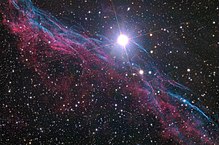52 Cygni
Appearance
| Observation data Epoch J2000 Equinox J2000 | |
|---|---|
| Constellation | Cygnus |
| A | |
| Right ascension | 20h 45m 39.75304s[1] |
| Declination | +30° 43′ 10.9756″[1] |
| Apparent magnitude (V) | 4.22[2] |
| B | |
| Right ascension | 20h 45m 40.206s[3] |
| Declination | +30° 43′ 12.96″[3] |
| Apparent magnitude (V) | 11.06[3] |
| Characteristics | |
| Spectral type | G9.5III[4] |
| U−B color index | +0.88[2] |
| B−V color index | +1.05[2] |
| Astrometry | |
| Radial velocity (Rv) | –0.72[5] km/s |
| Proper motion (μ) | RA: –8.98[1] mas/yr Dec.: +24.11[1] mas/yr |
| Parallax (π) | 16.22 ± 0.19 mas[1] |
| Distance | 201 ± 2 ly (61.7 ± 0.7 pc) |
| Details | |
| Mass | 2.07[6] M☉ |
| Radius | 13.81[6] R☉ |
| Luminosity | 89[7] L☉ |
| Surface gravity (log g) | 2.5[7] cgs |
| Temperature | 4,677[7] K |
| Metallicity [Fe/H] | −0.24[7] dex |
| Rotational velocity (v sin i) | 3.7[7] km/s |
| Age | 2.27[6] Gyr |
| Other designations | |
| A: HR 7942, HD 197912, HIP 102453, SAO 70467 | |
| B: TYC 2687-2652-1 | |
| Database references | |
| SIMBAD | A |
| B | |

52 Cygni is a giant star in the northern constellation of Cygnus with an apparent magnitude of 4.22. Based on its Hipparcos parallax, it is about 291 light-years (89 pc) away.
52 Cygni is a probable horizontal branch (red clump) star, fusing helium in its core, although there is a 25% chance that it is still on the red giant branch (RGB) and fusing hydrogen in a shell around an insert core. As a clump giant it would be 2.27 gyr old, but only 910 myr if it is an RGB star.[6] It shines with a bolometric luminosity of about 90 L☉ at an effective temperature of 4,677 K.[7] It has a radius of about 14 R☉.[6]
At an angular separation of 6.0″ from 52 Cygni is a faint magnitude 9.5 companion.[4]
References
- ^ a b c d e van Leeuwen, F. (2007), "Validation of the new Hipparcos reduction", Astronomy and Astrophysics, 474 (2): 653–664, arXiv:0708.1752, Bibcode:2007A&A...474..653V, doi:10.1051/0004-6361:20078357Vizier catalog entry
- ^ a b c Mermilliod, J.-C. (1986), "Compilation of Eggen's UBV data, transformed to UBV (unpublished)", Catalogue of Eggen's UBV Data. SIMBAD, Bibcode:1986EgUBV........0M
- ^ a b c Høg, E.; Fabricius, C.; Makarov, V. V.; Urban, S.; Corbin, T.; Wycoff, G.; Bastian, U.; Schwekendiek, P.; Wicenec, A. (2000). "The Tycho-2 catalogue of the 2.5 million brightest stars". Astronomy and Astrophysics. 355: L27. Bibcode:2000A&A...355L..27H.
- ^ a b Eggleton, P. P.; Tokovinin, A. A. (2008). "A catalogue of multiplicity among bright stellar systems". Monthly Notices of the Royal Astronomical Society. 389 (2): 869. arXiv:0806.2878. Bibcode:2008MNRAS.389..869E. doi:10.1111/j.1365-2966.2008.13596.x.
- ^ Famaey, B.; et al. (January 2005), "Local kinematics of K and M giants from CORAVEL/Hipparcos/Tycho-2 data. Revisiting the concept of superclusters", Astronomy and Astrophysics, 430 (1): 165–186, arXiv:astro-ph/0409579, Bibcode:2005A&A...430..165F, doi:10.1051/0004-6361:20041272
- ^ a b c d e Reffert, Sabine; Bergmann, Christoph; Quirrenbach, Andreas; Trifonov, Trifon; Künstler, Andreas (2015). "Precise radial velocities of giant stars". Astronomy & Astrophysics. 574: A116. arXiv:1412.4634. Bibcode:2015A&A...574A.116R. doi:10.1051/0004-6361/201322360.
- ^ a b c d e f Massarotti, Alessandro; et al. (January 2008), "Rotational and radial velocities for a sample of 761 HIPPARCOS giants and the role of binarity", The Astronomical Journal, 135 (1): 209–231, Bibcode:2008AJ....135..209M, doi:10.1088/0004-6256/135/1/209

